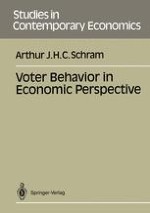1991 | OriginalPaper | Chapter
Expressed Preferences for Public Goods
Author : Dr. Arthur J. H. C. Schram
Published in: Voter Behavior in Economics Perspective
Publisher: Springer Berlin Heidelberg
Included in: Professional Book Archive
Activate our intelligent search to find suitable subject content or patents.
Select sections of text to find matching patents with Artificial Intelligence. powered by
Select sections of text to find additional relevant content using AI-assisted search. powered by
As discussed in Section 6.1, an alternative method for detecting individual preferences for public goods is by asking individuals about these preferences in surveys. This is an interesting alternative because, on the one hand, it enables an estimation of these preferences using a completely different method than the one discussed in the previous chapter, and, on the other hand, it allows one to investigate the differences between socio-economic groups with respect to these preferences, an important feature of this book. Contrary to the method discussed in Chapters 5 and 6, in this case no actual individual behavior (choices), but only expressed preferences are available. Bohm (1984) suggests two criteria which must be fulfilled by any method used to assess public good demand, an ‘intelligibility’ condition and a ‘verifiability’ condition. The former refers to the fact that the method (i.c., a survey) must be simple and easily understood by ‘ordinary’ people, whereas the latter indicates that the method must either be guaranteed accurate or simply verified. Intelligibility demands that the respondents understand the questions asked, whereas verifiability asks for a thorough analysis of potential sources of bias related to the questions. There are many sources of bias known in applying this method
